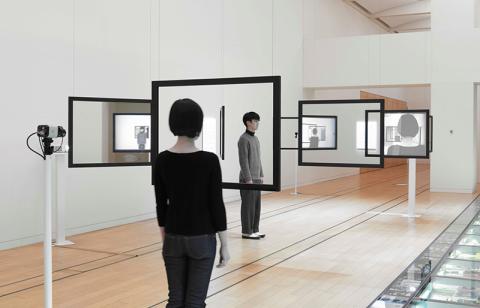Windows on Art

Photo: Yamamoto Tadasu. ”Installation view at Open Space 2016: Media Conscious, NTT InterCommunication Center [ICC], Tokyo, 2016”
Shakkei Trilogue: Walk Straight
2020
Wood, mirrors, cameras, projectors, screens
In addition to producing academic research, the Window Research Institute has also been organizing exhibition projects of window-themed work by various artists. For this exhibition, we have invited the artist Tsuda Michiko, who will be using camera footage, mirrors, and frames to create an installation in the JAPAN HOUSE main gallery and in the display windows along the public passage. Conceived to distort views of the venue’s interior and periphery together with the people within them, the piece is sure to provide spectators with a disorienting visual experience that will alter their perception of the space.
Entering into one of Tsuda Michiko’s recent interactive installations can be like walking into a Zen koan, the conundrum used by some Zen teachers to jolt their disciples into an understanding of reality.
An empty black window frame hangs from the ceiling, framing guests as they enter the gallery. Window frames with mirrors and screens along the gallery glass reflect images of gallery guests, inviting them to peer inside. Within these windows, however, they may see a reflection of themselves, or a projection of someone else who walked through the gallery a minute before them or perhaps the previous day. What they don’t see, but may soon understand, is that their own image will appear to someone else at a later time. In contrast with the bold outlines of the window frames that are central to the work, the lines between art and viewer, object and subject and past, present and future become a blur.
Tsuda, who was born in 1980 and lives and works in Tokyo, has always been interested in how we navigate through space and time. She has a BA in engineering from Tsukuba University, a BFA in Inter Media Art, and an MFA and PhD in Film and New Media from Tokyo University of the Arts. Much of her creative work, shown in Japan and internationally, is based on video and involves spatial choreography and collaborations with performers.
As part of the Windowology exhibition, Tsuda’s site-specific installation Shakkei Trilogue: Walk Straight (2020) uses projected camera footage, mirrors, and frames to create an installation in the JAPAN HOUSE main gallery and in the display windows along the public passage. Conceived to distort views of the venue’s interior and periphery together with the people within them, the work is sure to provide spectators with a multidimensional visual experience that will alter their perception of the space.
Short Films

You would come back there to see me again the following day.
Click for full film.

You would have gone there to see them by then.
Click for full film.
About the Artist

Tsuda Michiko
Tsuda focuses on creative work based on the characteristics of video. Performs as a unit “baby tooth” with Kamimura Megumi. Recent group exhibitions include “Inter+Play: Arts Towada 10th Anniversary Exhibition Part 1” (Towada Art Center, Aomori) in 2020, “Aichi Triennale 2019 : Taming Y/Our Passion” (Ito Residence, Aichi), “Roppongi Crossing 2019: Connexions” (Mori Art Museum, Tokyo) in 2019, “Open Space 2016: Media Conscious” (NTT InterCommunication Center [ICC], Tokyo) in 2016.
Solo exhibitions include “Trilogue” (TARO NASU, Tokyo) in 2020, “Observing Forest” (Zarya contemporary art center, Vladivostok) in 2017. Ph.D. Film and New Media Studies at the Graduate School of Film and New Media, Tokyo University of the Arts. Stayed in New York as grantee of the Asian Cultural Council (ACC) in 2019.
Windowology Exhibition | Gallery Images
©JAPAN HOUSE Los Angeles
Igarashi Tarō on Windows on Art

*Japanese names in this exhibition are written in the traditional Japanese order, with the family name first and personal name last.






